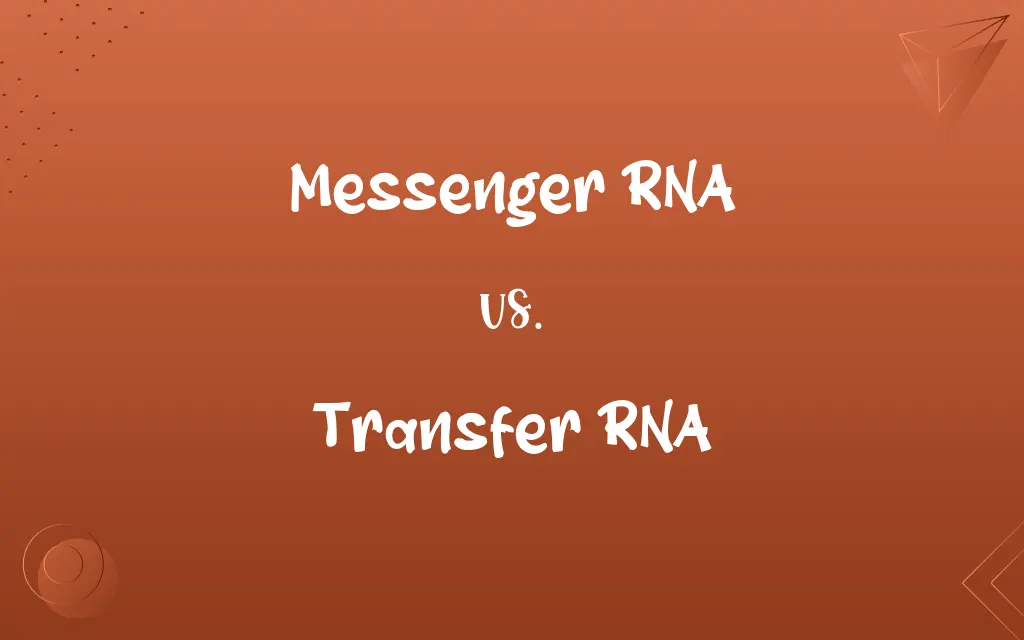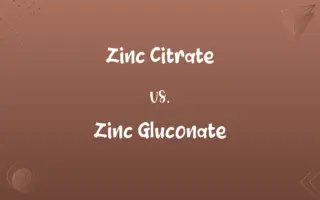Messenger RNA vs. Transfer RNA: Know the Difference

By Shumaila Saeed || Updated on December 25, 2023
Messenger RNA (mRNA) carries genetic information from DNA to ribosomes for protein synthesis, while Transfer RNA (tRNA) brings amino acids to ribosomes during protein assembly.

Key Differences
Messenger RNA (mRNA) is a type of RNA that transcribes genetic information from DNA, acting as a template for protein synthesis. Transfer RNA (tRNA) functions differently, as it transports specific amino acids to the ribosome during protein synthesis.
Shumaila Saeed
Dec 19, 2023
mRNA carries the genetic blueprint from the nucleus to ribosomes in the cytoplasm, guiding the sequence of amino acids in proteins. In contrast, tRNA translates the mRNA sequence into proteins by matching its anticodon with mRNA's codons to add the correct amino acids.
Shumaila Saeed
Dec 19, 2023
The role of mRNA is in the transcription phase of protein synthesis, conveying genetic instructions. tRNA, on the other hand, plays a crucial role in translation, interpreting the genetic code into a polypeptide chain.
Shumaila Saeed
Dec 19, 2023
mRNA is relatively larger and varies greatly in size, reflecting the length of the gene it transcribes. tRNA is smaller and more uniform in size, each molecule specific to one of the 20 amino acids.
Shumaila Saeed
Dec 19, 2023
In structure, mRNA is single-stranded and linear, carrying a sequence of nucleotides. tRNA has a unique cloverleaf structure with an anticodon loop and an amino acid attachment site.
Shumaila Saeed
Dec 19, 2023
ADVERTISEMENT
Comparison Chart
Function
Transports genetic information for protein synthesis.
Transports amino acids to ribosomes.
Shumaila Saeed
Dec 19, 2023
Role in Protein Synthesis
Acts in transcription and as a template in translation.
Assists in translation by matching codons.
Shumaila Saeed
Dec 19, 2023
Variability
Varies greatly depending on the protein being synthesized.
Relatively uniform, specific to amino acids.
Shumaila Saeed
Dec 19, 2023
Location in Cell
Travels from nucleus to ribosome.
Operates primarily at the ribosome.
Shumaila Saeed
Dec 19, 2023
ADVERTISEMENT
Messenger RNA and Transfer RNA Definitions
Messenger RNA
MRNA is a form of RNA that conveys genetic information from DNA to ribosomes.
In the process of synthesizing hemoglobin, mRNA carries the necessary genetic code from DNA.
Shumaila Saeed
Dec 10, 2023
Transfer RNA
TRNA translates the genetic code from mRNA into protein.
TRNA molecules match their anticodons with mRNA codons, assembling proteins accurately.
Shumaila Saeed
Dec 10, 2023
Messenger RNA
MRNA carries codons that specify amino acids in protein synthesis.
The sequence of codons in mRNA determines the structure of a synthesized protein.
Shumaila Saeed
Dec 10, 2023
Transfer RNA
TRNA is essential for translating mRNA into functional proteins.
Without tRNA, the genetic code in mRNA could not be interpreted into proteins.
Shumaila Saeed
Dec 10, 2023
Messenger RNA
MRNA transcribes genetic instructions for building proteins.
MRNA transcriptions of genes determine the types of enzymes produced in a cell.
Shumaila Saeed
Dec 10, 2023
ADVERTISEMENT
Transfer RNA
TRNA is a type of RNA that brings amino acids to ribosomes during protein assembly.
Each tRNA molecule is responsible for adding its specific amino acid to a growing polypeptide chain.
Shumaila Saeed
Dec 10, 2023
Messenger RNA
MRNA acts as a template for protein synthesis in cells.
Each mRNA molecule dictates the specific sequence of amino acids in a protein.
Shumaila Saeed
Dec 10, 2023
Transfer RNA
TRNA carries an anticodon corresponding to mRNA codons.
The anticodon loop of tRNA ensures the correct amino acid is incorporated into the protein.
Shumaila Saeed
Dec 10, 2023
Messenger RNA
MRNA is synthesized during transcription and used in translation.
During the synthesis of insulin, mRNA plays a key role in translating the gene.
Shumaila Saeed
Dec 10, 2023
Transfer RNA
TRNA has a cloverleaf structure for carrying amino acids.
The unique structure of tRNA allows it to transport amino acids efficiently.
Shumaila Saeed
Dec 10, 2023
Repeatedly Asked Queries
How is mRNA different from DNA?
mRNA is a single-stranded copy of a specific DNA segment, used for protein synthesis.
Shumaila Saeed
Dec 19, 2023
What does mRNA do?
mRNA carries genetic instructions from DNA for protein synthesis.
Shumaila Saeed
Dec 19, 2023
What is the role of mRNA in protein synthesis?
mRNA carries the genetic code, specifying the sequence of amino acids in a protein, to the ribosome, where protein synthesis occurs.
Shumaila Saeed
Dec 19, 2023
How is mRNA translated into proteins?
mRNA is translated into proteins through a process called translation, where ribosomes read the mRNA code and assemble amino acids accordingly.
Shumaila Saeed
Dec 19, 2023
What are some examples of mRNA-based vaccines?
COVID-19 vaccines like Pfizer-BioNTech and Moderna use mRNA technology to stimulate an immune response.
Shumaila Saeed
Dec 19, 2023
What is the significance of the wobble hypothesis in tRNA?
The wobble hypothesis allows some flexibility in base pairing between the tRNA anticodon and mRNA codon, allowing fewer tRNA species to cover all codons.
Shumaila Saeed
Dec 19, 2023
What is the role of tRNA?
tRNA brings specific amino acids to ribosomes to build proteins.
Shumaila Saeed
Dec 19, 2023
Is tRNA single or double-stranded?
tRNA is single-stranded, folding into a cloverleaf structure.
Shumaila Saeed
Dec 19, 2023
What is the overall function of tRNA in the cell?
tRNA acts as a crucial intermediary in the translation process, ensuring the accurate and efficient assembly of proteins based on the mRNA code.
Shumaila Saeed
Dec 19, 2023
What happens to mRNA after protein synthesis?
mRNA is eventually degraded by cellular processes once protein synthesis is complete.
Shumaila Saeed
Dec 19, 2023
How is tRNA charged with amino acids?
Aminoacyl-tRNA synthetases are enzymes responsible for attaching specific amino acids to tRNA molecules.
Shumaila Saeed
Dec 19, 2023
How many tRNA molecules are there for each amino acid?
There are multiple tRNA molecules for most amino acids, each with a distinct anticodon.
Shumaila Saeed
Dec 19, 2023
Can tRNA be reused in protein synthesis?
Yes, tRNA molecules can be recycled and used for multiple rounds of protein synthesis.
Shumaila Saeed
Dec 19, 2023
What role does tRNA play in the ribosome during translation?
tRNA molecules deliver amino acids to the ribosome, where they are incorporated into a growing polypeptide chain.
Shumaila Saeed
Dec 19, 2023
How does tRNA recognize the correct amino acid?
tRNA has an anticodon region that base-pairs with the complementary codon on mRNA, ensuring the correct amino acid is delivered.
Shumaila Saeed
Dec 19, 2023
How is mRNA synthesized?
mRNA is synthesized through a process called transcription, where a DNA template is used to create a complementary mRNA strand.
Shumaila Saeed
Dec 19, 2023
Share this page
Link for your blog / website
HTML
Link to share via messenger
About Author
Written by
Shumaila SaeedShumaila Saeed, an expert content creator with 6 years of experience, specializes in distilling complex topics into easily digestible comparisons, shining a light on the nuances that both inform and educate readers with clarity and accuracy.









































































